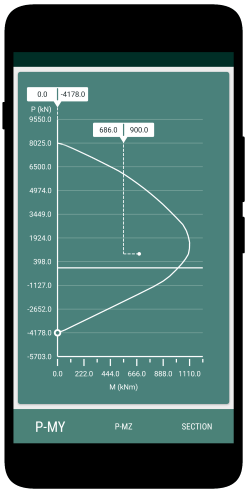A column is a special case of a compression member that is vertical. A reinforced concrete column is basically a vertical structural member, which helps to transfer the load from top to bottom in a framed structure. Specifically, columns transfer the compressive load from the top floor to the foundations.
To analyze a column sub. to biaxial bending, engineers consider both axial loads and bending moments. The effect of these forces can lead to different failure modes. In this blog, we delve into the of column design, the steps involved in design of columns which is under biaxial moment as per IS 456 : 2000.
The design procedure for the design of columns sub. to factored axial load Pu and biaxial moments Mux and Muy consists of the following steps:
- Assume c/s dim. and the area of steel and its distribution. Assume steel between 1% to 3%, and the Number – Diameter combination of bars for the same. Assume bars to be placed uniformly all around the periphery as this arrangement is better for biaxial bending.
- Compute concentric load Pnz as per the below eqn. $$ P_{nz} = 0.45 f_{ck} A_c + 0.75 f_y A_{sc} $$ and Pu/Pnz. Use chart 63 of SP 16 to evaluate the value of Pnz.
Computation of biaxial moments
- Determine the uni- axial moments Mnx and Mny of the section combined with the given axial load Pu , with the use of interaction curves for axial load and uniaxial moment. Select appropriate chart corresponding to d’/D , Draw a horizontal line from $P_u / (f_{ck}bD)$ continue it till it reaches a point corresponding to the value of $p/f_{ck}$. Drop a perpendicular on x-axis to give the value of $M_u / (f_{ck} bD^2) $. Calculate $ M_{ux1} $. Repeat the process to find the value of $ M_{uy1} $.
- Determine the adequacy of the column section using the below eqns $$(\frac{ M_{ux}} {M_{nx }})^{ alpha} + ( \frac{ M_{uy}}{ M_{ny}})^{alpha} <= 1 $$ $$ alpha = frac{2}{3} + frac{5}{3}frac{P_{u}}{P_{nz}} for , 0.2 < frac{P_{u}}{P_{nz}} < 0.8 $$
- When the above eqn’s value is greater than 1.0. Then this section is unsafe. When it is much lower than 1.0, the section is not economical. In such cases, the section should be modified, and steps 1-4 are to be repeated again until the resulting value of eqn. is nearly equal to 1.0.
Check this post to read about the detailing specification for a column section.
Conclusions
Designing column sections according to IS 456: 2000 involves a systematic approach that ensures the structural integrity and safety of buildings. By following the steps outlined in this blog post, engineers can effectively determine the dimensions and steel requirements for column sections.
Some of the key learnings are as follows:
- Understanding the Loads and Moments: Determining the factored loads and moments acting on the column is crucial for understanding the forces it will experience.
- Analysis for Section Selection: Analyzing the column for axial load and bending moments helps in selecting an appropriate section.
- Calculating Reinforcement Requirements: Calculating the required steel, considering allowable stresses, cover, and spacing, ensures the column can resist forces.
Column design
- RCC Column Design is a free app for designing reinforced concrete columns as per Indian Standards.
- RCC Design and detailing could be performed for uniaxial and biaxial bending conditions specified in IS456:2000
- Option to save the design projects in local storage.
- Detailed calculation steps presented for verification and validation.

This article was crafted by a group of experts at eigenplus to ensure it adheres to our strict quality standards. The individuals who contributed to this article are:
Author


